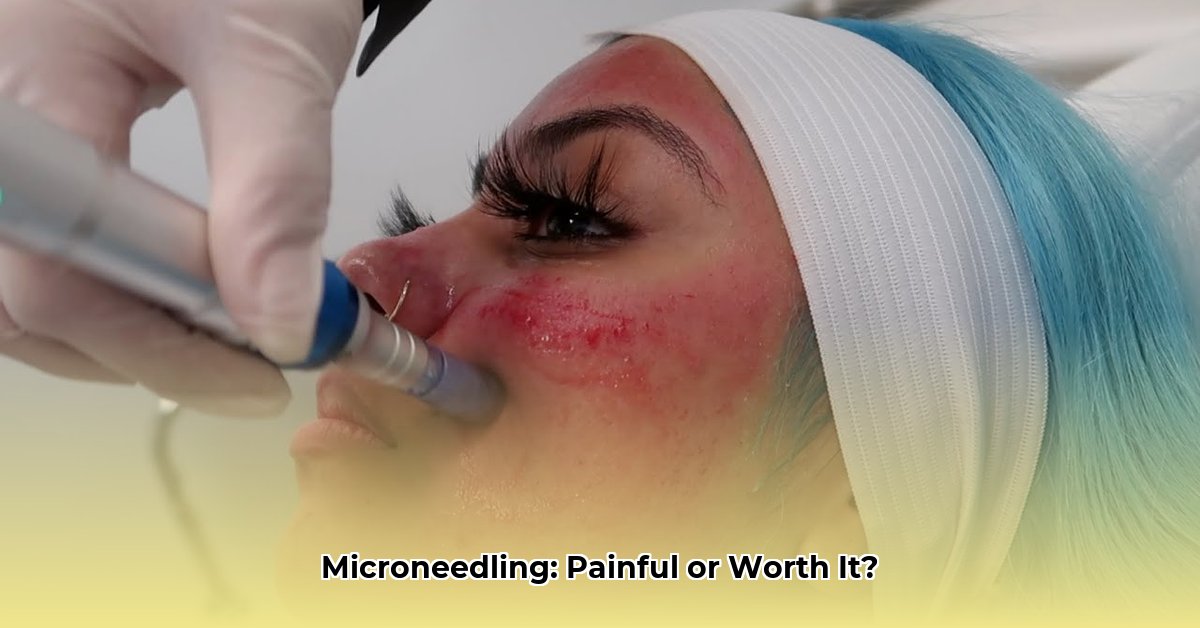Thinking about trying microneedling for collagen induction therapy and radiant skin? A common concern is: does it hurt? This comprehensive article provides an in-depth exploration of what to expect, from minor prickling sensations to potential discomfort levels, no matter if you’re considering at-home or professional treatments. We’ll delve into dermatologist-approved strategies for achieving optimal results, maximizing collagen production, and effectively caring for your skin after the procedure. For those considering other minimally invasive treatments, learn more about the pain levels associated with lip injections here. Is microneedling the right choice for you? Let’s explore!
Does Microneedling Hurt? Understanding Pain and Discomfort Levels
Let’s address the core question: Does microneedling hurt? The honest answer is nuanced. It’s essential to understand that pain perception is subjective and varies based on individual tolerance, the specific area being treated, and the type of procedure. Think of it as a spectrum: a mild prickle versus a slightly more noticeable poke. The discomfort hinges on several key factors, which we will unpack in this guide to help you prepare for your microneedling journey.
Understanding the Microneedling Magic and Collagen Stimulation
Microneedling involves using a device equipped with ultra-fine needles to create controlled micro-injuries on the skin’s surface. While the idea of tiny needles might seem intimidating, this process is designed to trigger the skin’s natural regenerative capabilities. These micro-injuries are the catalysts for stimulating increased collagen and elastin production. Collagen and elastin are crucial proteins that play a fundamental role in maintaining youthful, healthy-looking skin. Ultimately, this process contributes to reducing the appearance of wrinkles, enhancing skin texture, and minimizing the visibility of scars. So, yes, those tiny needles are the source of potential discomfort – but does microneedling hurt in the process?
Key Factors Influencing the Microneedling Pain Scale
Several factors can influence the level of sensation experienced during a microneedling procedure:
- Needle Depth: The depth to which the needles penetrate the skin plays a significant role in the level of sensation experienced. Deeper needles are more likely to cause greater sensation and potential discomfort. At-home microneedling kits often incorporate shorter needles, which typically result in less discomfort compared to professional treatments.
- Treatment Area: Certain areas of the face and body are inherently more sensitive than others. For instance, areas around the eyes, forehead, and mouth are generally more sensitive due to thinner skin and underlying nerve endings.
- Personal Pain Tolerance: Individual pain thresholds vary considerably. What one person perceives as a mild tingling sensation, another might experience as more uncomfortable.
- Numbing Cream: The use of topical anesthetics can significantly reduce discomfort during microneedling. Many professional microneedling treatments include the application of numbing cream to minimize pain and enhance patient comfort.
- Microneedling Device Quality: The quality and design of the microneedling device can also impact the level of discomfort experienced. Professional-grade devices are often designed to minimize discomfort and provide more consistent results compared to at-home options.
What to Expect During the Microneedling Treatment Process
During the microneedling treatment, many individuals describe the sensation as a light scratching or tiny stinging feeling on the skin. Some people also compare it to the sensation of fine sandpaper gently brushing against the skin. The application of a numbing cream can significantly reduce discomfort, transforming the experience into a mild or barely noticeable sensation. However, it’s important to keep in mind that certain areas of the face or body may still feel more sensitive despite the use of numbing cream.
So, does microneedling hurt without numbing cream? In most cases, microneedling without numbing cream is more likely to be uncomfortable, particularly when deeper needle penetration is involved.
Anticipating Post-Treatment Sensations and Recovery
Following a microneedling session, it’s common to experience mild redness and swelling in the treated area, similar to a mild sunburn. These effects are generally temporary and typically subside within a day or two. Any discomfort experienced during the recovery period is usually manageable with over-the-counter pain relievers like ibuprofen or acetaminophen.
Minimizing Discomfort: Before, During, and After the Procedure
To optimize comfort and effectiveness during your microneedling journey, consider the following steps:
- Consult a Professional: Before undergoing microneedling, schedule a consultation with a qualified dermatologist or aesthetician. This will allow you to discuss any concerns or expectations you may have, and the professional can assess your skin and determine the most suitable treatment approach.
- Request Numbing Cream: Don’t hesitate to ask about the application of numbing cream before the procedure. Topical anesthetics can significantly reduce discomfort, making the experience more comfortable and manageable.
- Adhere to Aftercare Instructions: Following the aftercare instructions provided by your practitioner is crucial for minimizing irritation and promoting healing. This typically includes gentle cleansing, avoiding harsh skincare products, and consistently using sunscreen to protect the treated skin from sun damage.
Weighing the Pros and Cons of Microneedling
As with any cosmetic treatment, microneedling has its own set of advantages and disadvantages that should be carefully considered before making a decision.
| Pros | Cons |
|---|---|
| Improves skin texture and tone | Potential for mild side effects (redness, swelling, dryness) |
| Reduces the appearance of scars and wrinkles | Requires multiple sessions to achieve optimal results |
| Stimulates collagen and elastin production | May not be suitable for individuals with certain skin conditions |
| Relatively quick and minimally invasive procedure | The cost of treatment can vary depending on the provider |
Making Informed Decisions About Microneedling for Your Skin Type
Before undergoing microneedling, it’s essential to thoroughly research different clinics and practitioners. Inquire about their experience, the types of devices they use, and their patient comfort management strategies. Open communication and transparency are key to ensuring a positive and satisfactory experience.
While the question “Does microneedling hurt?” is a valid concern, the answer ultimately depends on individual factors. With proper preparation, including the use of numbing cream, any discomfort experienced during microneedling is usually manageable. Microneedling is generally considered a safe and effective procedure for improving skin texture, reducing wrinkles, and minimizing the appearance of scars. Continuously refined techniques and an increased understanding of the procedure mean that consulting with a qualified professional is always the best approach for addressing your specific skin needs and concerns.
How to Minimize Microneedling Side Effects at Home and Maximize Collagen Production
Microneedling can be performed both at home and in a professional setting, each offering unique advantages and considerations.
Key Takeaways:
- At-home microneedling offers a more affordable option compared to professional treatments; however, professional treatments utilizing longer needles tend to yield faster, more pronounced results.
- Shorter needles in at-home devices limit the treatment’s depth, potentially reducing its effectiveness, particularly for addressing severe scarring or deeper skin issues.
- The stimulation of collagen production is a gradual process that takes time, regardless of the treatment type chosen. With professional treatments, individuals often observe quicker visible improvements in skin texture and elasticity.
- The risk of infection and potential scarring increases with at-home microneedling due to challenges in maintaining proper sterilization and technique.
- Longer needles used in professional settings can cause more discomfort during the procedure, but the use of numbing cream helps to manage and alleviate this discomfort.
- Needle length plays a profound role in stimulating collagen production and achieving significant improvements in skin texture and elasticity.
Understanding Microneedling: The Pain Threshold and Needle Depth
Microneedling, although effective for skin rejuvenation, isn’t entirely pain-free. Does it hurt? The short answer, again, is: it depends. Needle depth is the primary factor influencing the level of discomfort experienced during microneedling. Shorter needles, commonly found in at-home devices, typically cause minimal discomfort, often described as a mild scratching sensation. Longer needles, utilized by professionals, penetrate deeper into the skin, leading to more noticeable discomfort; however, the application of numbing creams can effectively mitigate the pain.
Minimizing Discomfort During and After Professional Microneedling Treatments
For those opting for professional microneedling, effective pain management is essential. Topical numbing creams are commonly applied before the procedure to help alleviate discomfort. In addition to numbing cream, your dermatologist or aesthetician may also recommend other pain-reducing techniques to enhance your comfort during the treatment. Post-treatment, it’s common to experience some redness and swelling in the treated area. Applying ice packs can help minimize these effects and provide relief.
Step-by-Step Guide: How to Minimize Microneedling Side Effects at Home
At-home microneedling offers convenience and affordability, but minimizing potential side effects requires diligent care and attention to detail.
Before Your At-Home Microneedling Treatment:
- Begin by thoroughly cleansing your skin with a gentle cleanser to remove any dirt, oil, or makeup. Pat your skin dry with a clean towel.
- Sterilize your microneedling device carefully, following the manufacturer’s instructions, to prevent infection.
- If desired, apply a thin layer of numbing cream to the treatment area, allowing it sufficient time to take effect according to the
- Your Perfect Bento Box Bag For Fresh And Tidy Meals - December 2, 2025
- Korean Meal Prep Made Easy For Delicious Weekday Meals - December 1, 2025
- Korean Food Meal Prep Makes Flavorful Weekday Meals Simple - November 30, 2025










